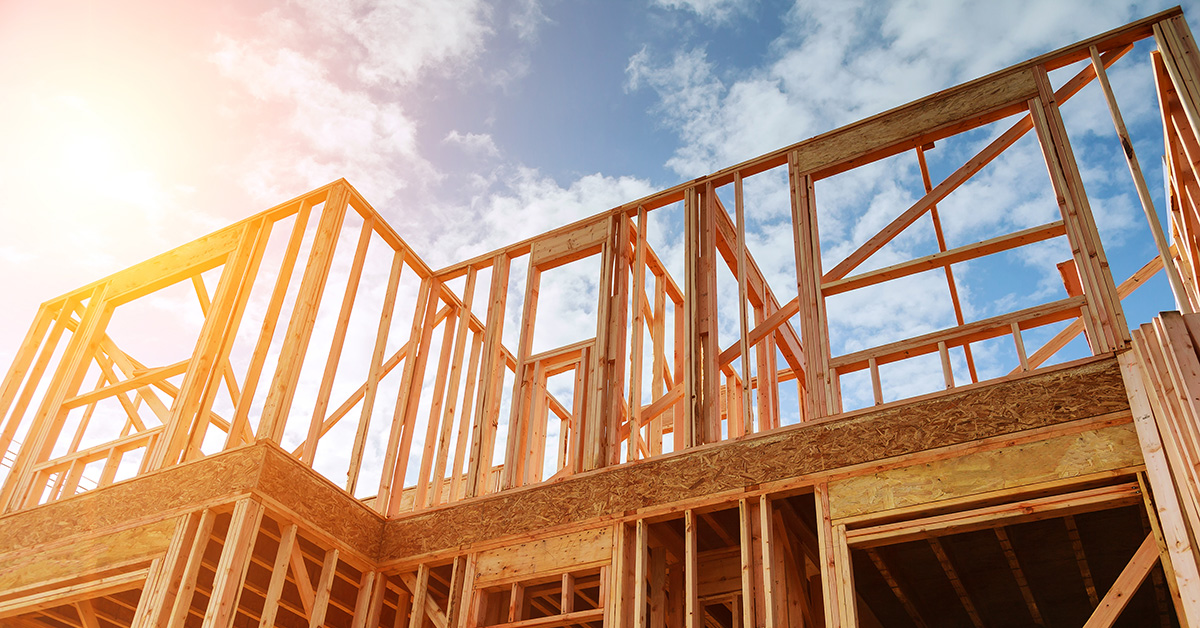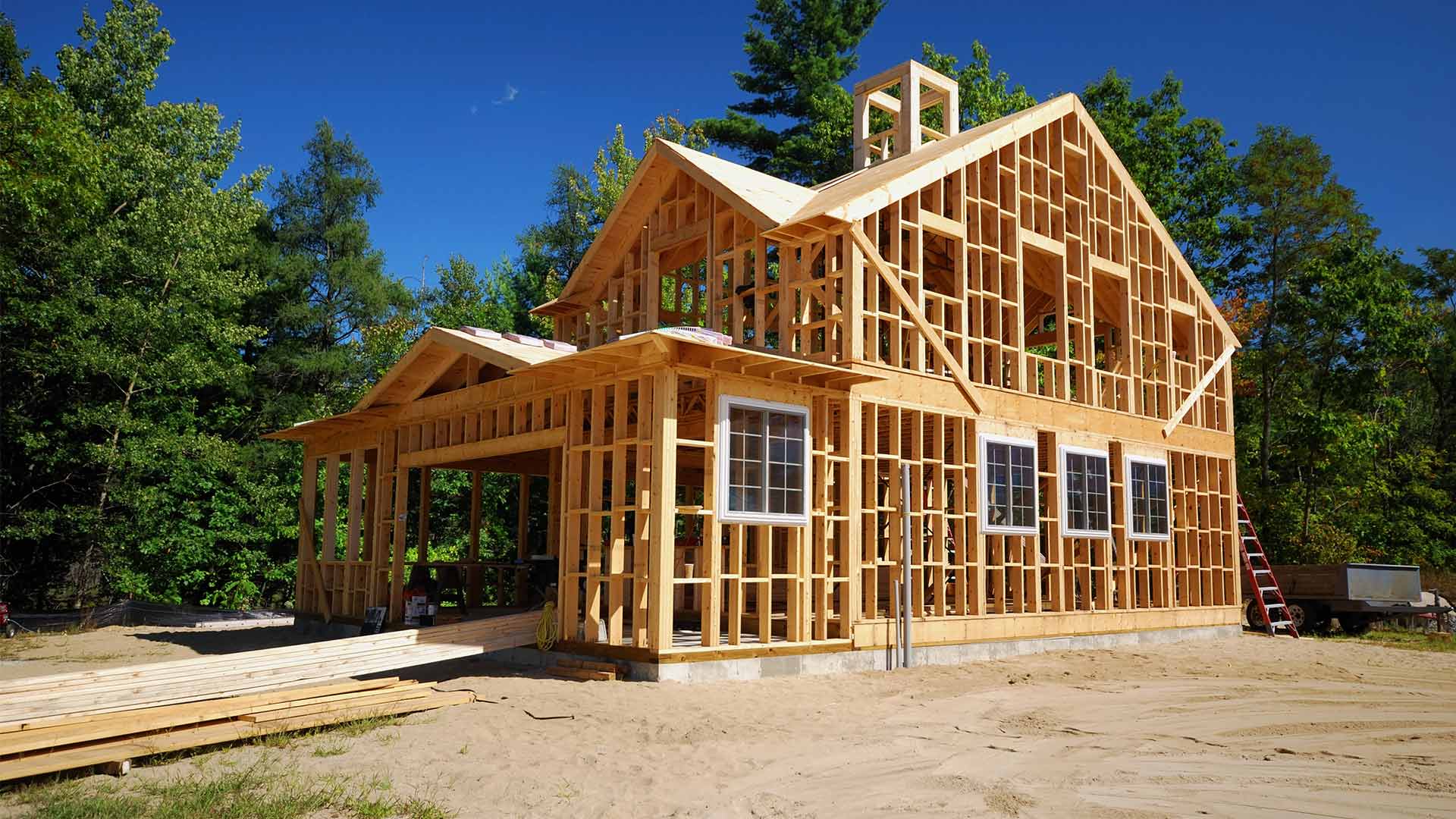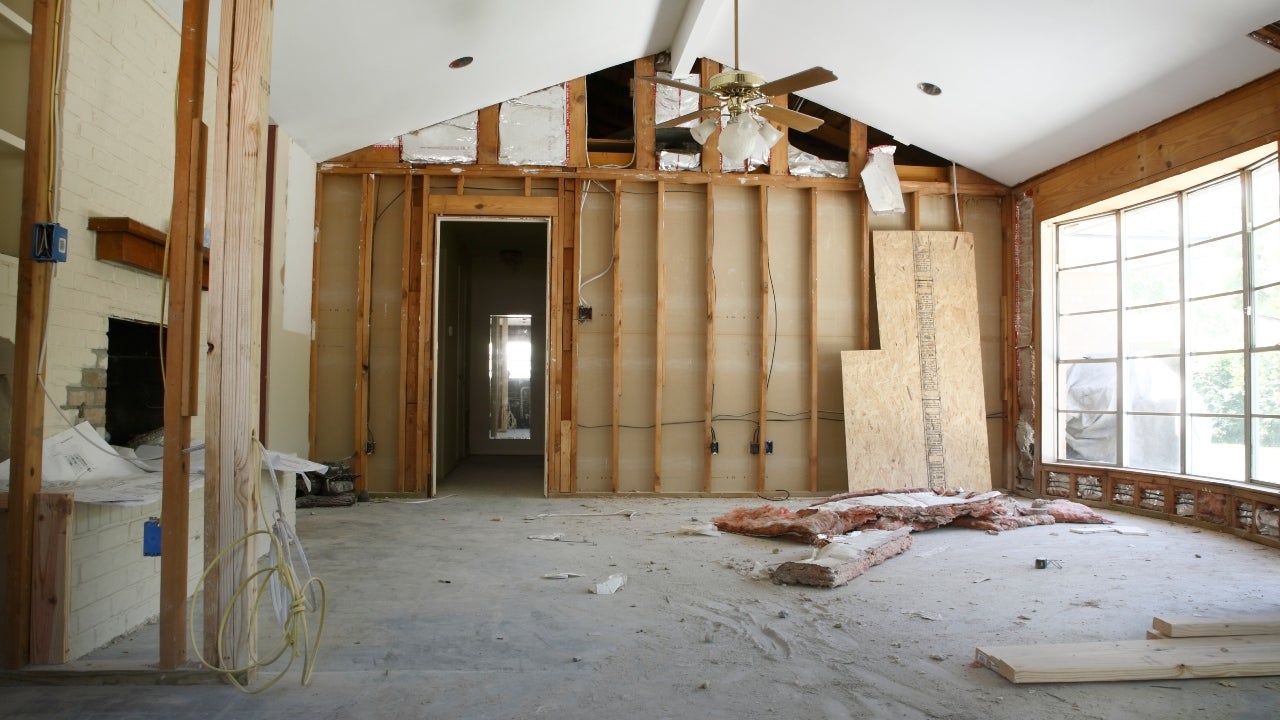Home>diy>Building & Construction>How To Get A Construction Loan For A Remodel


Building & Construction
How To Get A Construction Loan For A Remodel
Modified: January 9, 2024
Learn how to secure a building construction loan for your remodel project. Get the financing you need to bring your vision to life.
(Many of the links in this article redirect to a specific reviewed product. Your purchase of these products through affiliate links helps to generate commission for Storables.com, at no extra cost. Learn more)
Introduction
Undertaking a remodeling project can be an exciting endeavor, whether you’re adding an extension to your home, renovating a kitchen, or transforming a basement into a functional living space. However, financing such a project can often be a challenge. This is where construction loans come into play. Understanding how to get a construction loan for your remodel can provide you with the necessary funds to turn your vision into a reality.
Construction loans differ from traditional home loans in that they are specifically designed to fund building or remodeling projects. These loans typically have more flexible terms and approval requirements based on the estimated post-construction value of the property. By securing a construction loan, you can have access to the funds needed to cover the costs of materials, labor, permits, and other expenses during the renovation process.
Before embarking on the journey of obtaining a construction loan, it’s crucial to assess your remodeling needs and determine the scope of the project. Do you have a clear vision of what you want to achieve? Are you working with a contractor, architect, or designer? Knowing the answers to these questions will help you accurately estimate the budget required and determine the loan amount you will need.
Once you have a clear understanding of your remodeling needs, you can start researching and finding the right lender for your construction loan. It’s important to choose a lender experienced in construction financing and familiar with the remodeling process. Look for lenders who offer competitive interest rates, favorable loan terms, and excellent customer service. Don’t hesitate to ask for recommendations from friends, family, or professionals in the construction industry.
Preparing your loan application is the next step in the process. Your application should include detailed information about your project, including the scope of work, timeline, and estimated costs. This will give the lender a comprehensive understanding of your remodeling plans and help them assess the feasibility of the project. It’s also essential to provide any supporting documents required by the lender, such as construction plans, contractor bids, and permits.
Calculating the loan amount and terms is a crucial aspect of the construction loan process. The lender will evaluate your project’s estimated costs and determine the loan amount based on a percentage of the total budget. Typically, construction loans cover around 80% to 95% of the project cost, depending on the lender’s policies. The loan term is usually based on the expected construction timeline, with the option to extend the term if necessary.
Once you’ve completed your loan application and gathered all the required documents, it’s time to submit your application to the lender for review. The lender will examine your application, assess your creditworthiness, and consider the project’s feasibility. The approval process may take some time, so it’s essential to be patient and proactive in providing any additional information or documentation required.
Once your construction loan is approved, the lender will disburse the funds to cover the costs associated with your remodeling project. These disbursements are usually made in installments, known as “draws,” at specific stages of the construction process. It’s essential to work closely with your contractor and monitor the construction progress to ensure that the funds are used appropriately and efficiently.
Managing construction costs is an ongoing process throughout your remodeling project. It’s crucial to keep track of expenses, review invoices, and communicate regularly with your contractor to avoid any cost overruns or delays. Consider having a contingency fund in place to account for unexpected expenses that may arise during the renovation process.
Once your remodeling project is complete, it’s time to celebrate your achievement and enjoy your newly transformed space. Remember to communicate with your lender regarding the transition from the construction loan to a permanent mortgage or repayment plan.
Getting a construction loan for your remodel is a complex process, but with careful planning, research, and preparation, you can successfully finance your renovation project. By understanding the steps involved in acquiring a construction loan, you can navigate the process confidently and turn your remodeling dreams into a stunning reality.
Key Takeaways:
- Understanding the construction loan process, assessing remodeling needs, and finding the right lender are crucial for successfully securing funds and completing a remodeling project within budget and on time.
- Effective cost management, open communication with contractors, and attention to final details are essential for a smooth loan disbursement, successful project completion, and the enjoyment of a newly renovated space.
Read more: How To Get A Construction Loan For A Home
Understanding Construction Loans
When it comes to financing a remodeling project, construction loans can be a valuable tool. These specialized loans are designed to provide funds specifically for building or renovating a property. Understanding how construction loans work can help you make informed decisions throughout the loan application and disbursement process.
Construction loans differ from traditional home loans in several ways. Firstly, they are typically short-term loans with a term of one to three years, depending on the lender and the duration of the construction project. This is because construction loans are designed to cover the costs of the construction or renovation phase of a property, after which the loan is typically transitioned into a permanent mortgage.
Secondly, construction loans are based on the estimated value of the property after the construction or renovation is complete. This is known as the “after-completion value” or “appraised value.” The lender determines the loan amount based on a percentage of the projected value, typically ranging from 80% to 95%.
In addition to the loan amount, the lender also considers the “loan-to-value” (LTV) ratio, which compares the loan amount to the property’s appraised value. The LTV ratio is used to assess the risk of the loan and determine the interest rate and terms. A lower LTV ratio is generally more favorable, as it indicates a lower risk for the lender.
Construction loans are usually disbursed in installments, also known as “draws,” at different stages of the construction process. The specific draw schedule is predetermined and agreed upon between the lender, borrower, and contractor. Each draw represents a portion of the loan amount that is released to cover the costs incurred during that construction phase.
It’s important to note that construction loans require rigorous documentation and oversight. The lender wants to ensure that the funds are being used for the intended purpose and that the construction project is progressing as planned. This is why lenders often require detailed construction plans, contractor bids, permits, and regular inspections to monitor the progress of the project.
During the construction phase, the borrower typically pays only the interest on the loan, known as “interest-only payments.” This allows the borrower to manage cash flow more effectively during the construction period. Once the construction is complete, the loan is usually converted into a permanent mortgage, and the borrower begins making principal and interest payments.
It’s important to understand that every construction loan may have specific terms, requirements, and limitations, depending on the lender. Some lenders may offer construction-to-permanent loans, which combine the construction loan and permanent mortgage into a single loan. Others may require a separate permanent mortgage to be obtained after the construction is completed.
When considering a construction loan for your remodeling project, it’s crucial to research and compare multiple lenders to find the best terms and rates that suit your needs. Working with a financial advisor or mortgage broker experienced in construction financing can also provide valuable guidance throughout the process.
By understanding the mechanics of construction loans and familiarizing yourself with the lender’s requirements and expectations, you can navigate the loan process with confidence and secure the necessary funds to bring your remodeling project to life.
Assessing Your Remodeling Needs
Before embarking on a remodeling project, it’s essential to assess your needs and establish a clear vision of what you want to achieve. This step is crucial in determining the scope of the project and estimating the budget required. Consider the following factors when assessing your remodeling needs:
- Identify your objectives: Start by identifying the primary objectives of your remodel. Are you looking to create additional space, improve functionality, or update the aesthetics of your home? Understanding your goals will help prioritize the project and allocate resources accordingly.
- Evaluate your current space: Assess the existing layout, features, and condition of your home. Identify areas that require improvement or modification. Consider aspects such as plumbing, electrical systems, structural integrity, and overall functionality.
- Consult with professionals: Engage with professionals such as architects, contractors, and interior designers to discuss your remodeling needs. Their expertise and insights can help you refine your ideas and provide recommendations on design options, materials, and cost estimates.
- Consider your lifestyle: Take into account your lifestyle and how the remodel will enhance your daily living. If you have a growing family, you may need additional space or rooms. If you love cooking, focus on the kitchen and dining areas. Tailor the remodel to suit your specific needs and preferences.
- Set a realistic budget: It’s important to establish a realistic budget for your remodeling project. Consider the cost of materials, labor, permits, and any additional fees or unexpected expenses. Be sure to account for a contingency fund to cover unforeseen circumstances that may arise during the renovation process.
- Research and gather inspiration: Explore various sources of inspiration, such as design magazines, online platforms, and home improvement shows. Create a vision board or a digital file to collect ideas, color palettes, and design elements that resonate with your style and preferences.
- Understand the impact on property value: Assessing your remodeling needs also involves considering the potential impact on your property value. While personal satisfaction and enjoyment should be the primary focus, it’s important to consider whether the renovations will enhance the resale value of your home should you decide to sell in the future.
By thoroughly assessing your remodeling needs, you can define the scope of your project and ensure that it aligns with your goals and budget. This will lay a solid foundation for the loan application process and guide you in making informed decisions throughout the remodeling journey.
Finding the Right Lender
When it comes to obtaining a construction loan for your remodeling project, finding the right lender is crucial. The lender you choose can significantly impact the terms, rates, and overall success of your loan. Here are some considerations to keep in mind when searching for the right lender:
- Experience in construction financing: Look for a lender who has experience in construction financing. Construction loans have unique requirements and complexities compared to traditional home loans. A lender familiar with the construction process will have a better understanding of the loan’s nuances and can provide valuable guidance throughout the project.
- Reputation and credibility: Research the reputation and credibility of potential lenders. Read reviews, seek referrals, and check their track record in the industry. Review their online presence and evaluate their customer service. A reputable lender with positive customer feedback is more likely to provide a smooth and reliable loan experience.
- Competitive interest rates and loan terms: Compare interest rates and loan terms from multiple lenders to ensure you get the best possible deal. A slight difference in interest rates can make a significant impact on the overall cost of your loan. Consider factors such as the length of the loan term, repayment options, and any associated fees.
- Flexibility in loan options: Look for a lender who offers flexible loan options tailored to your specific remodeling project. Some lenders may specialize in certain types of renovations or have unique programs that align with your needs. Consider whether the lender offers construction-to-permanent loans, which streamline the transition from the construction loan to a permanent mortgage.
- Transparent communication: Communication with your lender is essential throughout the loan process. Look for a lender who communicates clearly, promptly, and transparently. They should be able to address your questions and concerns and keep you informed of the progress and requirements of your loan application.
- Availability of pre-qualification: Some lenders offer pre-qualification processes that help you determine your eligibility for a loan before submitting a formal application. Pre-qualification can give you an idea of the loan amount you may qualify for, giving you more confidence when planning your remodeling project.
- Customer support and assistance: Consider the level of customer support and assistance offered by the lender. A responsive and knowledgeable support team can provide guidance, answer your queries, and support you throughout the loan process. Look for lenders who prioritize customer satisfaction and have a reputation for excellent service.
Take the time to research and compare different lenders to find the one that best meets your needs. Consult with financial advisors or mortgage brokers who specialize in construction financing. They can provide valuable insights and recommendations based on their industry knowledge and connections.
Remember, finding the right lender is an important step in securing the funding necessary to bring your remodeling project to life. A reliable and well-suited lender will not only provide the financial resources you need but also offer support and guidance throughout the loan process, making your remodeling journey smoother and more successful.
Preparing Your Loan Application
Preparing your loan application is a critical step in obtaining a construction loan for your remodeling project. A well-prepared application will increase your chances of loan approval and ensure that your lender has a comprehensive understanding of your project. Here are some key steps to consider when preparing your loan application:
- Gather project details: Start by gathering all the necessary project details. This includes a clear description of the remodeling project, including the scope of work, materials to be used, and any special features or upgrades. Provide specific information about the changes you want to make and how they will improve the functionality and value of your property.
- Consult with professionals: Seek advice and insights from professionals such as architects, contractors, or interior designers. Their expertise can help you refine your project plans and provide accurate cost estimates. They may also be able to assist you with creating detailed construction plans that will be essential for your loan application.
- Estimate the project cost: Develop a detailed budget that clearly outlines the estimated costs for the remodeling project. Factor in expenses such as materials, labor, permits, equipment rentals, and any additional fees or unexpected expenses. It’s important to be thorough and provide a realistic estimate to ensure your loan amount adequately covers the project.
- Compile required documents: Your loan application will require various documents, so it’s important to be organized and gather all the necessary paperwork. This may include construction plans, contractor bids, permits, property surveys, proof of insurance, financial statements, and your credit history report. Check with your chosen lender for a comprehensive list of required documents.
- Provide personal financial information: Your lender will require personal financial information, including income statements, bank statements, tax returns, and proof of assets or liabilities. Be prepared to provide detailed information about your employment, income sources, and any outstanding debts. This information helps lenders assess your financial stability and ability to repay the loan.
- Include supporting documentation: In addition to the loan application and financial information, include any supporting documentation that can strengthen your application. This may include references from contractors or professionals involved in the project, photographs or sketches depicting your remodeling plans, and any relevant permits or approvals obtained from local authorities.
- Double-check your application: Before submitting your loan application, review it thoroughly to ensure accuracy and completeness. Check for any missing or inconsistent information and make any necessary corrections. It may be helpful to have a second pair of eyes, such as a trusted advisor or family member, review your application as well.
Remember, a well-prepared loan application is essential to demonstrate your commitment to the project and assure the lender that you have carefully planned and considered all aspects. The more detailed and organized your application, the easier it will be for the lender to evaluate your project and make an informed decision.
If you have any questions or uncertainties during the application process, don’t hesitate to reach out to your lender or seek advice from professionals experienced in construction financing. Their guidance can help ensure that your loan application is accurate, complete, and stands the best chance of being approved.
Read more: How To Get Church Construction Loans
Gathering Required Documents
Gathering the required documents is an important part of the loan application process when seeking a construction loan for your remodeling project. These documents provide necessary information to the lender and help them assess the feasibility and potential risks associated with your project. Here are some key documents you will likely need to gather:
- Construction plans: Detailed construction plans are essential for the lender’s evaluation of your project. These plans should include architectural drawings, floor plans, elevations, and any other relevant details that depict the scope and design of your remodeling project. Ensure that the plans are accurate, comprehensive, and clear.
- Contractor bids: Obtain bids from licensed and reputable contractors who will be involved in your remodeling project. These bids should outline the cost of labor, materials, and other necessary expenses. Multiple bids can provide comparative pricing, demonstrating that you have conducted thorough research and chosen a competitive option.
- Permits and approvals: Ensure that you have obtained all the necessary permits and approvals required by your local building authorities. Provide documentation of these permits and approvals to demonstrate that your project complies with regulations and is authorized to proceed. This can include building permits, zoning permits, architectural review board approvals, and any other regulatory documentation.
- Property surveys: Include any property survey documents you have that outline the precise boundaries of your property and its existing structures. This information helps the lender understand the context of your remodeling project and assess its potential impact on the property’s value and functionality.
- Proof of insurance: Provide proof of insurance coverage for your property and the remodeling project. This may include homeowner’s insurance, builder’s risk insurance, or any other relevant insurance policies. Proof of insurance demonstrates that you have taken steps to mitigate potential risks during the construction process.
- Financial statements: Prepare and provide financial statements that accurately reflect your financial situation. This can include bank statements, income statements, tax returns, and any other financial documents that showcase your income, assets, and liabilities. These statements help lenders assess your financial stability and ability to repay the loan.
- Credit history report: Obtain a copy of your credit history report from a reputable credit reporting agency. Your credit report provides information about your creditworthiness and financial track record. Lenders will review this report to evaluate your creditworthiness and assess the level of risk associated with granting you a loan.
- Additional documentation: Depending on your specific circumstances and the requirements of the lender, there may be additional documentation required. This could include proof of employment, recent pay stubs, personal identification documents, and other supporting materials that provide a comprehensive overview of your financial and personal situation.
It’s important to carefully review the documentation requirements provided by your lender. Ensure that you gather all the necessary documents, make copies as needed, and store them securely. Organize them in a logical and easily accessible manner to facilitate the loan application process.
Keep in mind that different lenders may have slightly different document requirements, so it’s crucial to communicate openly with your lender and clarify any questions or concerns you may have. By providing the requested documents accurately and promptly, you can streamline the application process and move closer to securing the construction loan for your remodeling project.
Calculating Loan Amount and Terms
Calculating the loan amount and terms is a crucial step in the construction loan process. This step determines the amount of funding you will receive for your remodeling project and the repayment terms associated with the loan. Here are some key factors to consider when calculating the loan amount and terms:
- Evaluate project cost: Begin by evaluating the overall cost of your remodeling project. This includes considering the costs of materials, labor, permits, and any additional expenses. Consult with contractors and professionals to obtain accurate estimates for each aspect of the project.
- Determine loan-to-value (LTV) ratio: The loan-to-value ratio is the percentage of the loan amount compared to the appraised value of the property. Lenders typically lend between 80% to 95% of the appraised value, depending on their policies and guidelines. The lower the LTV ratio, the more favorable the loan terms and interest rates will typically be.
- Assess your cash contribution: Calculate the amount of cash you are prepared to contribute to the project. This includes your down payment, if required by the lender, as well as any personal savings you are willing to invest in the remodeling project. The cash contribution reduces the loan amount and affects the overall terms of the loan.
- Consider contingency funds: It’s wise to allocate a portion of your budget for contingency funds. These funds act as a buffer to cover unexpected expenses or changes that may arise during the remodeling process. Typically, a contingency fund should be around 10% of the overall project cost.
- Estimate loan duration: Determine the expected duration of your remodeling project. Construction loans are typically short-term loans, ranging from one to three years. The loan term is based on the anticipated completion timeline of the project. It’s essential to have a realistic estimate of the project duration to align it with the loan term.
- Assess interest payment options: During the construction phase, you will generally only need to make interest payments on the loan. These are known as interest-only payments. Calculate the expected amount of interest payments you will need to make during the construction period. Discuss this with the lender to understand the payment schedule and its impact on your cash flow.
- Evaluate your repayment capacity: Consider your financial ability to repay the loan. Evaluate your income, expenses, and existing financial obligations to determine the loan amount and terms that fit within your repayment capacity. This helps ensure that you can comfortably meet the loan payments without compromising your financial well-being.
Once you have estimated the project cost, determined the loan-to-value ratio, and calculated your cash contribution, you can work with the lender to finalize the loan amount and terms. The lender will use these factors, along with other considerations such as your creditworthiness, to determine the specific loan terms, including interest rates and repayment schedules.
It’s important to communicate openly with your lender and provide them with accurate information regarding your project cost and financial capabilities. This helps them tailor the loan terms to your specific needs and ensure that you secure an appropriate loan amount for your remodeling project.
Remember that every lender may have slightly different criteria and guidelines when calculating loan amounts and terms. It’s advisable to consult with multiple lenders, compare their offerings, and choose the one that best aligns with your financial goals and remodeling project requirements.
Tip: Before applying for a construction loan for a remodel, make sure to have a detailed plan, budget, and timeline in place. Lenders will want to see a clear vision for the project before approving the loan.
Submitting Your Application
Once you have prepared your loan application and gathered all the necessary documents, it’s time to submit your application to the lender. Submitting a well-organized and complete application increases your chances of a smooth and efficient loan approval process. Here are some key steps to follow when submitting your application:
- Review your application: Before submitting your application, review it carefully to ensure that all the information provided is accurate and up-to-date. Check for any missing or inconsistent information and make any necessary corrections. It may be helpful to have a second pair of eyes, such as a trusted advisor or family member, review your application as well.
- Double-check the document checklist: Review the lender’s document checklist and ensure that you have included all the required documents. Make copies as needed and organize them in a logical and easily accessible manner. Check that all documents are legible and in good condition.
- Submit the application promptly: Once you are satisfied with the thoroughness and accuracy of your application, submit it as soon as possible. Delaying the submission may lead to delays in the loan approval process. Follow the lender’s instructions regarding the submission method, whether it be online, in person, or via mail.
- Keep copies for your records: Make copies of the submitted application and all the accompanying documents for your own records. This allows you to have a complete set of the application materials and serve as a reference throughout the loan process.
- Follow up with the lender: After submitting your application, it’s important to follow up with the lender to ensure they have received it and to inquire about the next steps in the process. Maintain open lines of communication and be proactive in providing any additional information or documentation that may be requested.
- Be patient: The loan approval process may take some time, so it’s important to be patient during this period. The lender needs to review your application, assess your creditworthiness, and evaluate the feasibility of your project. Avoid constantly contacting the lender for updates, but do not hesitate to reach out if you have any concerns or questions.
By submitting a complete and well-prepared application, you increase the likelihood of a timely and smooth loan approval process. Remember to provide accurate information, be responsive to any additional requests from the lender, and maintain open communication throughout the process.
If you have chosen a reputable lender, they will keep you informed of the progress of your application and notify you once a decision has been made. In the event that your application is approved, you can proceed to the next steps in the construction loan process. If your application is declined, take the opportunity to discuss the reasons with the lender and explore alternative options.
Submitting your application is a significant milestone in obtaining a construction loan for your remodeling project. Maintain a proactive and positive attitude, and be prepared to provide any necessary information or additional documentation requested by the lender. With patience and persistence, you’ll be one step closer to securing the funds needed to bring your remodeling vision to life.
Loan Approval Process
The loan approval process is a crucial step in obtaining a construction loan for your remodeling project. Once you have submitted your application and supporting documents, the lender will undertake a comprehensive evaluation to determine whether to approve your loan. Here is an overview of the loan approval process:
- Application review: The lender will review your application, ensuring that it is complete and accurate. They will assess your creditworthiness, review your financial information, and evaluate the feasibility of your remodeling project. This initial review helps the lender determine whether your application meets their criteria and moves it forward in the approval process.
- Credit check and underwriting: The lender will conduct a credit check, examining your credit history and credit score to assess your repayment ability and overall financial stability. Additionally, an underwriter will review your application and financial information in detail to determine the level of risk associated with your loan. They will assess factors such as your income, existing debts, and credit history.
- Assessment of the remodeling project: The lender reviews the details of your remodeling project, including the scope of work, costs, and timeline. They may consult with contractors or experts to evaluate the feasibility and potential value of your project. The lender considers these factors to ensure that the loan amount aligns with the expected post-renovation value of your property.
- Additional information or documentation: If the lender requires any additional information or documentation to make an informed decision, they will request it at this stage. It’s essential to respond promptly and provide the requested information to avoid unnecessary delays in the approval process.
- Evaluation of collateral: The lender will assess the collateral used to secure the loan, which is typically the property undergoing renovation. They will determine the appraised value of the property and evaluate its condition. The lender wants to ensure that the value of the collateral adequately covers the loan amount.
- Loan decision and communication: Based on the review and assessment process, the lender will make a decision regarding the approval of your loan. They will communicate this decision to you, either in writing or verbally. If your loan is approved, the lender will provide you with the details of the loan terms, including the interest rate, loan amount, repayment schedule, and any other pertinent conditions.
- Loan agreement and closing: If you accept the loan offer, you will proceed to the loan agreement and closing stage. At this stage, you will finalize the loan documentation, sign the necessary paperwork, and pay any applicable closing costs. The lender will disburse the funds to cover the costs of your remodeling project based on an agreed-upon draw schedule.
It’s important to note that the loan approval process can vary depending on the lender’s policies, the complexity of your project, and other factors. It’s advisable to maintain open lines of communication with the lender throughout the process and promptly respond to any requests for information or documentation.
During the loan approval process, it’s essential to be patient and remain proactive. Understand that the lender must conduct due diligence to evaluate the risk and ensure that the loan is a suitable fit for your project and financial circumstances. By cooperating and providing the necessary information, you can help facilitate a smoother approval process.
If your loan application is not approved, don’t lose hope. Take the opportunity to discuss the reasons for the denial with the lender and explore alternative options or modifications to your project plans. With perseverance and a thorough understanding of the loan approval process, you’ll be better equipped to achieve the financing you need for your remodeling project.
Loan Disbursement and Monitoring
Once your construction loan for your remodeling project has been approved and the loan agreement has been signed, the loan disbursement and monitoring phase begins. This phase involves the actual distribution of funds to cover the costs of the project and ongoing monitoring to ensure that the funds are being used appropriately. Here’s what you need to know:
- Loan disbursement schedule: The loan disbursement schedule, often referred to as “draws,” outlines when and how the funds will be released to you or your contractor. The schedule is typically based on specific milestones or stages of the construction process, as agreed upon in the loan agreement. Each draw represents a portion of the loan amount that will cover the associated expenses for that stage of the remodeling project.
- Communication with the lender: It’s crucial to maintain open communication with the lender throughout the loan disbursement phase. Inform them of the project’s progress, provide updates on the completion of each stage, and notify them when you or your contractor is ready for a draw. This helps ensure a smooth disbursement process and builds a relationship of trust between you and the lender.
- Inspections: Most lenders require periodic inspections to verify that the project is following the agreed-upon plans, remains on schedule, and complies with local building codes. The lender will send an inspector to assess the completed work before approving each draw. This is to protect the lender’s investment and ensure that the funds are being used for their intended purpose.
- Submission of draw requests: To initiate a draw, you or your contractor will submit a draw request to the lender. This request typically includes documentation such as invoices, receipts, and photographs of completed work for the stage being invoiced. The lender will review the draw request and associated documentation before making a disbursement.
- Disbursement process: Once the lender approves a draw request, they will disburse the agreed-upon amount directly to you or your contractor. The disbursement may be made via check, wire transfer, or other agreed-upon methods. It’s important to ensure that the funds are used solely for the purpose of the construction project and closely monitor any expenses.
- Monitoring construction progress and costs: Throughout the remodeling project, it’s crucial to monitor the progress and costs. Keep track of invoices, receipts, and any other financial documentation related to the construction expenses. Regularly review the spending against the approved budget and be vigilant about cost overruns or unexpected expenses. Maintaining control over the project’s finances helps prevent delays and disputes.
- Controlling funds: It’s advisable to have a designated bank account for the construction funds. Use this account to receive the loan disbursements and make payments related to the remodeling project. This ensures that the funds are properly accounted for and allows for easier tracking of expenses and drawdowns for both you and the lender.
- Close collaboration with your contractor: Maintain frequent communication and a close working relationship with your contractor throughout the loan disbursement and monitoring phase. Keep them informed of any changes or updates, ensure they provide timely documentation for draw requests, and coordinate with them regarding inspections and progress reports. Effective collaboration helps streamline the disbursement process.
Remember, the lender has a vested interest in ensuring that the loan funds are used appropriately and in accordance with the loan agreement. By adhering to the disbursement process, maintaining open communication, and monitoring the project’s progress and costs, you can foster a successful relationship with the lender and ensure a smooth loan disbursement and monitoring experience.
Lastly, always refer to the specific terms and requirements outlined in your loan agreement and consult with your lender if you have any questions or concerns about the disbursement and monitoring process.
Managing Construction Costs
Managing construction costs is an essential aspect of successfully completing your remodeling project within budget. By effectively managing and controlling your costs, you can ensure that your funds are utilized efficiently and that your project stays on track. Here are some tips to help you manage construction costs:
- Create a detailed budget: Start by creating a comprehensive budget that includes all anticipated expenses for your remodeling project. Consider materials, labor, permits, consultant fees, and any other relevant costs. Be realistic and leave room for unforeseen expenses by setting aside a contingency fund of around 10% to cover unexpected costs that may arise during the construction process.
- Get multiple bids: Obtain bids from multiple contractors or suppliers for the various components of your remodeling project. Compare the bids to ensure that you are receiving competitive pricing and choose the most cost-effective option that meets your quality standards. Be cautious of bids that seem excessively low, as they may indicate the use of substandard materials or inexperienced contractors.
- Track and review expenses consistently: Keep a close eye on your expenses and regularly review your spending against the approved budget. Maintain meticulous records of invoices, receipts, and other financial documentation related to the project. This will help you identify any deviations from the budget and address them promptly to avoid cost overruns.
- Communicate openly with your contractor: Effective communication with your contractor is crucial for managing construction costs. Clearly communicate your expectations, budget constraints, and priorities from the outset. Regularly discuss the progress of the project and review any changes or potential additional costs. Make sure that your contractor is transparent about costs and consults with you before making any adjustments.
- Consider value engineering: Value engineering involves finding alternative materials or construction methods that provide the same or similar functionality at a lower cost. Work closely with your contractor and design professionals to explore cost-saving options without compromising quality or aesthetics. Value engineering can help you identify areas where you can trim costs without sacrificing the overall vision of your remodel.
- Avoid scope creep: Scope creep refers to the gradual expansion of the project’s original scope, leading to additional costs. While it’s natural to want to add or modify elements during the remodeling process, be cautious of unnecessary changes that can increase expenses. Assess each proposed change in terms of its impact on the budget and timeline before making a decision.
- Take advantage of discounts and sales: Keep an eye out for discounts, promotions, or sales on materials and fixtures for your remodeling project. Timing your purchases strategically can save you a significant amount of money. Consider buying in bulk or planning your purchases during seasonal sales to maximize savings.
- Regularly review your project schedule: Inefficient project timelines can result in additional costs. Regularly review your project schedule and ensure that the work progresses according to plan. Delays can lead to increased labor costs, extended rental equipment fees, and potential project disruptions. Identify any potential bottlenecks or risks and address them promptly to mitigate their impact on the timeline and costs.
Managing construction costs requires ongoing vigilance and proactive management. By establishing a detailed budget, monitoring expenses, communicating effectively with your contractor, and making informed decisions, you can stay on top of your project’s finances and successfully manage your construction costs.
Remember that unexpected expenses may still arise during the remodeling process due to unforeseen circumstances. Flexibility and adaptability are crucial in managing these unexpected costs. Stay focused, remain open to alternative solutions, and proactively address any issues that may impact your budget. With diligent cost management, you can achieve your remodeling goals without breaking the bank.
Completing the Remodeling Project
Completing the remodeling project is an exciting milestone that marks the culmination of your hard work and planning. It’s the stage where your vision comes to life and you get to enjoy the transformed space. As you near the end of the construction process, there are several important steps to ensure a successful completion:
- Final inspections: Before considering the project complete, it’s important to schedule and pass any final inspections required by your local building authority. These inspections ensure that the construction work meets the necessary codes and regulations. Coordinate with your contractor to facilitate the inspections and address any issues that may arise.
- Punch-list completion: Create a punch-list, which is a list of remaining tasks or minor adjustments that need to be completed. Walk through the remodel with your contractor and note any deficiencies or items that require attention. Work with your contractor to address these items promptly and ensure that they are resolved to your satisfaction.
- Final touches and cleaning: Pay attention to the final touches of your remodeling project. Clean the space thoroughly, removing any construction debris or dust. Take time to inspect the details, such as paint finishes, hardware installation, and overall cleanliness. Make sure that the space is ready for occupancy and meets your expectations.
- Transition planning: If you temporarily relocated during the remodel, plan for the transition back to your newly renovated space. Coordinate with your utilities to ensure the services are turned on, and schedule any necessary move-in or delivery logistics. Make necessary arrangements for any final installations, such as appliances or furnishings.
- Review warranties and guarantees: Take time to review and understand the warranties and guarantees provided by your contractor or suppliers. Ensure that you have all the necessary warranty documentation for products and materials used in your remodeling project. Address any warranty issues promptly to ensure that you receive appropriate support or replacements if needed.
- Finalize financial matters: Review your loan documents and communicate with your lender regarding the transition from the construction loan to a permanent mortgage or repayment plan. Ensure that your financial obligations are clarified and that you have a clear understanding of your mortgage payments, interest rates, and any associated terms.
- Document the completed project: Take photographs of the completed remodel to document the transformation. These photos can serve as a reminder of the before-and-after changes and can be shared with friends and family. They can also be valuable for future reference or if you plan to sell the property in the future.
- Enjoy your newly renovated space: Finally, take the time to truly enjoy and appreciate your newly renovated space. Celebrate the accomplishment of completing your remodeling project and take pride in the hard work and planning that went into creating a home that reflects your style and meets your needs.
Completing the remodeling project is an exciting and fulfilling moment. By following these steps and paying attention to the final details, you can ensure that your remodeling project is successfully finished and ready for you to enjoy for years to come. Take a moment to bask in the satisfaction of a job well done and relish in the transformed space that you’ve brought to life.
Conclusion
Embarking on a remodeling project is an exciting endeavor that allows you to transform your living space and create a home that reflects your unique style and needs. Acquiring a construction loan for your remodel is a crucial step in securing the necessary funds to bring your vision to life. Understanding the loan process, assessing your remodeling needs, and finding the right lender are essential to a successful outcome.
Throughout the loan application process, it’s important to gather all required documents, prepare a thorough application, and submit it in a timely manner. By providing accurate information and maintaining open communication with your lender, you increase your chances of loan approval.
Once your loan is approved, the loan disbursement and monitoring phase begins. Regular communication with your lender, accurate record-keeping, and adherence to the agreed-upon draw schedule help ensure that the funds are used effectively and efficiently, keeping your project on budget.
Managing construction costs is key to the success of your remodeling project. Creating a detailed budget, tracking expenses, and regularly reviewing costs against the budget help you stay on track and avoid cost overruns. Effective communication with your contractor, value engineering, and making informed decisions can further contribute to cost management.
As you near the completion of your remodeling project, final inspections, punch-list completion, and attention to the final details are essential to achieving a successful outcome. Reviewing warranties, finalizing financial matters, and documenting the completed project are also important steps to ensure a smooth transition and peace of mind.
In conclusion, navigating the construction loan process and successfully completing your remodeling project requires careful planning, effective communication, and attention to detail. By understanding the loan process, assessing your needs, carefully managing costs, and collaborating with your contractor and lender, you can transform your living space into a haven that brings you joy for years to come.
Remember, every remodeling project is unique, and the loan process may vary depending on your specific circumstances and the lender you choose. Be proactive, seek guidance from professionals when needed, and approach the project with patience and flexibility. With determination and thorough preparation, you can turn your remodeling dreams into a reality.
Frequently Asked Questions about How To Get A Construction Loan For A Remodel
Was this page helpful?
At Storables.com, we guarantee accurate and reliable information. Our content, validated by Expert Board Contributors, is crafted following stringent Editorial Policies. We're committed to providing you with well-researched, expert-backed insights for all your informational needs.














0 thoughts on “How To Get A Construction Loan For A Remodel”